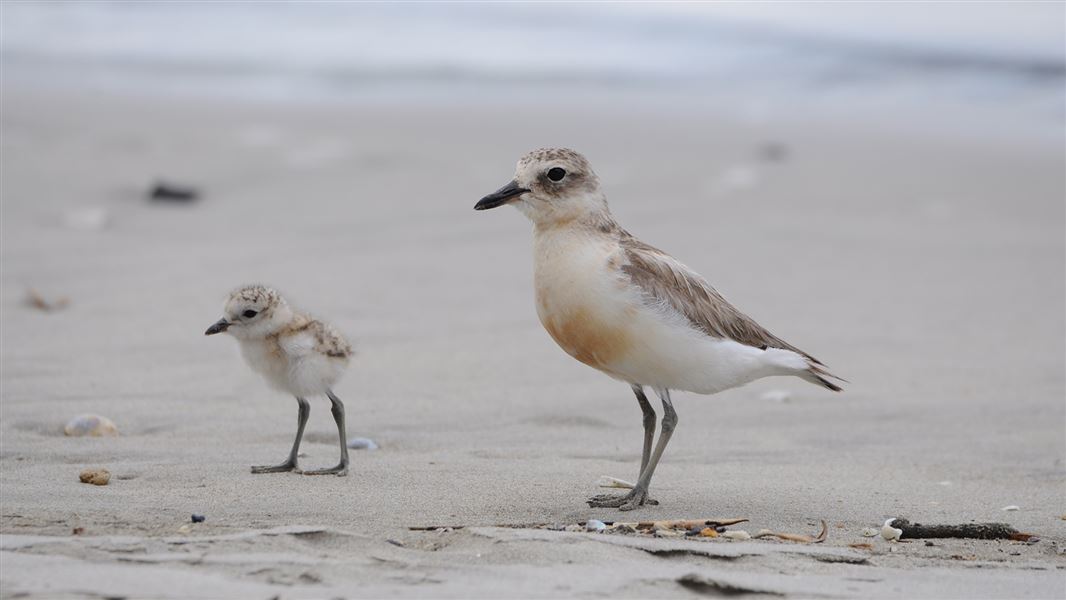Archived content: This media release was accurate on the date of publication.
Date: 06 September 2022
The Department of Conservation’s (DOC) Coromandel District team has put out the call for informal volunteer 'dotterel minders' as the shore-dwelling birds’ breeding season gets underway.
Amy Blair, DOC’s Coromandel Supervisor, says the search for residents keen to become dotterel minders coincides with Conservation Week, which this year puts an emphasis on giving back to nature and the work of volunteers, who make a vital contribution to conservation work across the country.
New Zealand’s wildlife is in crisis, with more than 4,000 of our native animals and plants threatened or at risk. Conservation Week is a chance to bring everyone together to do something, big or small, to create change.
“The dotterel breeding season is upon us, running from September to March – and that’s why we need the extra surveillance from our communities,” says Amy Blair.
“We can’t monitor the beaches where dotterels are found all the time, so having volunteer dotterel minders in our seaside locations is vital to protecting these precious little birds and their offspring.”
There are 43 sites across the peninsula which are either monitored by DOC, volunteers, or a combination of both. Coincidentally, there are also 43 dotterel-minding volunteers supporting DOC’s efforts – but not all beaches are covered, and more volunteers are needed.
The main objectives of the dotterel programme and its volunteers are to fence off nesting sites, install signage to warn and educate the public and, most importantly, provide a fledgling count at the end of the season to gauge productivity. The time commitment for volunteers is a couple of hours each week.
Once chicks can fly, at around six weeks old, they tend to fly away to flocking sites at quiet, food-rich beaches and bays. Amy Blair says if minders don’t see them physically fly for more than 10 seconds, it’s difficult to prove they have fledged successfully.
“Dotterel Ranger Frouk Miller and I can only make it to each beach once a week so it’s easy for us to miss this vital milestone, which is why our volunteers are so important,” says Amy Blair.
“Most of the volunteers are living near the beach they patrol, and some of them can manage the manual labour just fine, so myself and Frouk just check in weekly with each volunteer.
“Others leave the fencing and signage up to us, and they just keep an eye on things during their daily walk along the beach. The programme would be nowhere near as successful without the volunteers, they are our eyes on the beach. Some have been doing it for decades!”
There are six locations around Coromandel identified as flocking sites for dotterels, with good food supply: Coromandel Harbour, Colville, Matarangi, Opoutere, Pauanui/Tairua and Whangamata.
Coromandel residents interested in contributing to the dotterel minding programme are asked to contact the Whitianga DOC office in the first instance, by emailing community.coromandel@doc.govt.nz.
“We’ll have a chat about how and when you can contribute, and provide some guidance on a small but very important time commitment. A key aspect of this volunteering is advocacy – letting people know how their behaviour on the beaches can support protection of the dotterels.”
The easiest way for beach goers to help protect these tenacious birds is to give them plenty of space – and keep their dogs under control at all times.
Domestic cats should be kept inside at night, as an adult bird incubating eggs or an unfledged chick make easy prey. People and dogs should not linger near fenced areas as while adults are distracting the ‘threat’, exposed eggs and chicks can quickly perish.
Background information
Once widespread around the coast of the North Island, the Northern New Zealand Dotterel – tūturiwhatu pukunui – can now only be seen in Northland, the Coromandel Peninsula and some beaches north of Tauranga.
Although classified as ‘Recovering’, this charismatic little shorebird is more at risk than some species of kiwi, with only about 2,500 individuals remaining.
They nest in open areas, often close to residential or developed areas. Nests are easily destroyed by careless feet, dogs and off-road vehicles.
Dotterels breed in monogamous pairs and most often return to the same area of the same beach, year after year.
Contact
For media enquiries contact:
Email: media@doc.govt.nz
